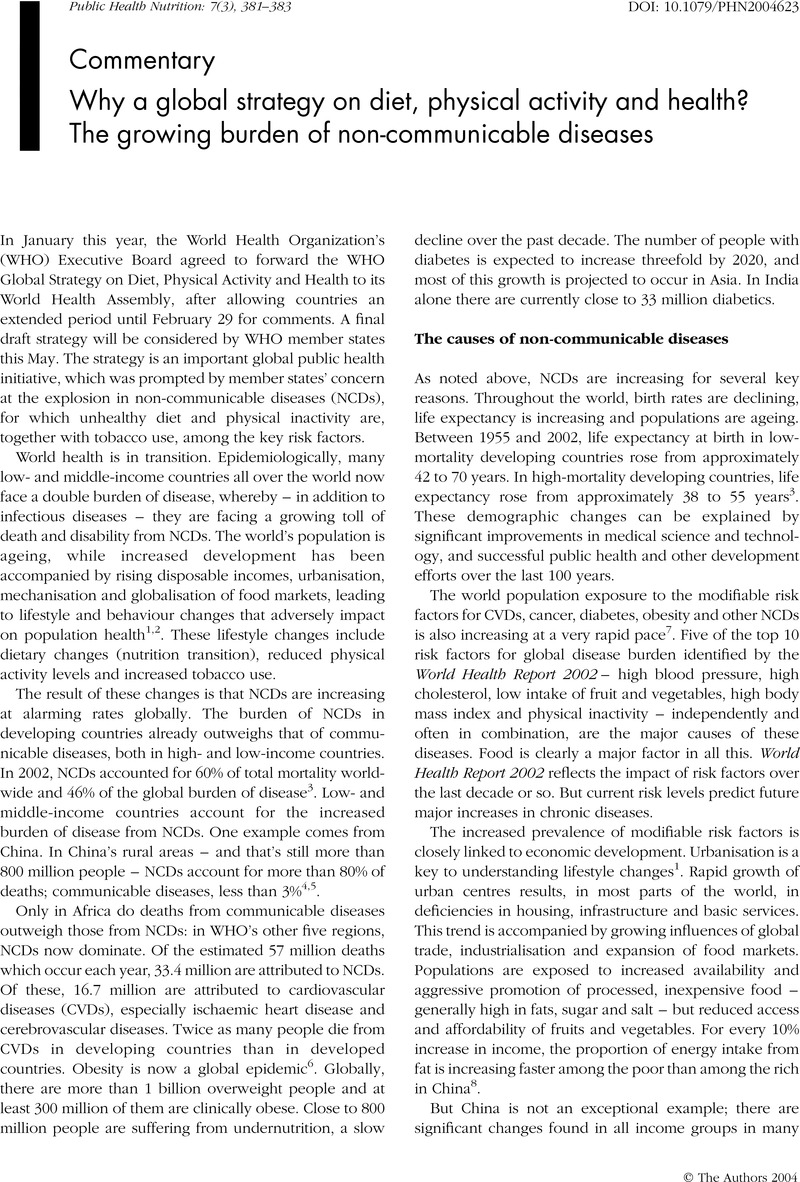Crossref Citations
This article has been cited by the following publications. This list is generated based on data provided by Crossref.
Margetts, Barrie
2004.
Editorial.
Public Health Nutrition,
Vol. 7,
Issue. 3,
p.
361.
Bauman, Adrian
and
Craig, Cora L
2005.
The place of physical activity in the WHO Global Strategy on Diet and Physical Activity.
International Journal of Behavioral Nutrition and Physical Activity,
Vol. 2,
Issue. 1,
Popkin, Barry M.
Conde, Wolney
Hou, Ningqi
and
Monteiro, Carlos
2006.
Is There a Lag Globally in Overweight Trends for Children Compared with Adults?.
Obesity,
Vol. 14,
Issue. 10,
p.
1846.
Steele, Rebekah
Mummery, Kerry W.
and
Dwyer, Trudy
2007.
Development and process evaluation of an Internet-based physical activity behaviour change program.
Patient Education and Counseling,
Vol. 67,
Issue. 1-2,
p.
127.
Labie, Dominique
2007.
Le diabète en Afrique sub-saharienne.
médecine/sciences,
Vol. 23,
Issue. 3,
p.
320.
Mabry, R. M.
Reeves, M. M.
Eakin, E. G.
and
Owen, N.
2010.
Evidence of physical activity participation among men and women in the countries of the Gulf Cooperation Council: a review.
Obesity Reviews,
Vol. 11,
Issue. 6,
p.
457.
Williams, Joanne W.
Canterford, Louise
Hesketh, Kylie D.
Hardy, Pollyanna
Waters, Elizabeth B.
Patton, George C.
and
Wake, Melissa
2011.
Changes in body mass index and health related quality of life from childhood to adolescence.
International Journal of Pediatric Obesity,
Vol. 6,
Issue. 2-2,
p.
e442.
Majer, Istvan M.
Nusselder, Wilma J.
Mackenbach, Johan P.
and
Kunst, Anton E.
2011.
Life Expectancy and Life Expectancy With Disability of Normal Weight, Overweight, and Obese Smokers and Nonsmokers in Europe.
Obesity,
Vol. 19,
Issue. 7,
p.
1451.
Lau, Robin S.
Johnson, Shanthi
and
Kamalanabhan, T. J.
2012.
Healthy Life Expectancy in the Context of Population Health and Ageing in India.
Asia Pacific Journal of Public Health,
Vol. 24,
Issue. 1,
p.
195.
Ul-Haq, Zia
Mackay, Daniel F.
Fenwick, Elisabeth
and
Pell, Jill P.
2013.
Meta-Analysis of the Association between Body Mass Index and Health-Related Quality of Life among Children and Adolescents, Assessed Using the Pediatric Quality of Life Inventory Index.
The Journal of Pediatrics,
Vol. 162,
Issue. 2,
p.
280.
Ward, Leigh C.
Poston, Lucilla
Godfrey, Keith M.
and
Koletzko, Berthold
2013.
Assessing Early Growth and Adiposity: Report from an EarlyNutrition Academy Workshop.
Annals of Nutrition and Metabolism,
Vol. 63,
Issue. 1-2,
p.
120.
Jauch-Chara, Kamila
and
Oltmanns, Kerstin M.
2014.
Obesity – A neuropsychological disease? Systematic review and neuropsychological model.
Progress in Neurobiology,
Vol. 114,
Issue. ,
p.
84.
Jara, Eddy A.
Ritterman Weintraub, Miranda
Clifton-Hawkins, Nancy
and
Martinez, Nestor
2014.
Effects of a Promotor Training on Local School Wellness Advocacy Capacity.
Health Promotion Practice,
Vol. 15,
Issue. 1,
p.
63.
Waltner, Georg
Schwarz, Michael
Ladstätter, Stefan
Weber, Anna
Luley, Patrick
Bischof, Horst
Lindschinger, Meinrad
Schmid, Irene
and
Paletta, Lucas
2015.
New Trends in Image Analysis and Processing -- ICIAP 2015 Workshops.
Vol. 9281,
Issue. ,
p.
425.
Slater, Sandy J.
Nicholson, Lisa
Abu Zayd, Haytham
and
Chriqui, Jamie Friedman
2016.
Does Pedestrian Danger Mediate the Relationship between Local Walkability and Active Travel to Work?.
Frontiers in Public Health,
Vol. 4,
Issue. ,
Cecil, Charlotte AM
Walton, Esther
and
Barker, Edward D
2016.
Prenatal Diet and Childhood ADHD: Exploring the Potential Role of
IGF2
Methylation
.
Epigenomics,
Vol. 8,
Issue. 12,
p.
1573.
Chiavarino, Claudia
Poggio, Chiara
Rusconi, Franco
Beretta, Anna Angela Rachele
and
Aglieri, Stefano
2019.
Psychological factors and self-rated health: An observative study on cardiological patients.
Journal of Health Psychology,
Vol. 24,
Issue. 14,
p.
1993.
Aguilar, Eduardo
Bolaños, Marc
and
Radeva, Petia
2019.
Regularized uncertainty-based multi-task learning model for food analysis.
Journal of Visual Communication and Image Representation,
Vol. 60,
Issue. ,
p.
360.
Losada-Rojas, Lisa Lorena
and
Gkritza, Konstantina
2021.
Individual and location-based characteristics associated with Autonomous Vehicle adoption in the Chicago metropolitan area: Implications for public health.
Journal of Transport & Health,
Vol. 22,
Issue. ,
p.
101232.
Islam, M. Mazharul
2021.
Life Expectancy and Healthy Life Expectancy of Adults in Oman: Does Women’s Longer Life Expectancy than Men Mean Success or Burden for Women?.
International Journal of Statistics in Medical Research,
Vol. 10,
Issue. ,
p.
136.



